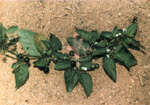| Latin Name | Solanum nigrum Linn. (Soalnaceae) |
| English Name | Black night-shade |
| Sanskrit Names | Kakamachi, Kakahva |
| Hindi Name | Makoi |
 History: It has been used from earlier times in Ayurveda along with other ingredients in heart disease. It is also stated that the berries of this plant can be eaten without danger. It appears to have been used chiefly by the Greeks as a local application to inflamed parts. In Persia it has been described to be useful in dropsy and as a diuretic. Most Arabian and Persian writers of Materia Medica describe four different kinds. Mr. M. Shariff in his supplement to the pharmacopeia of India speaks very favourably of it as a cathartic and diuretic. In 1890, the physiological action of solanine,the active principle of this plant, had been investigated by Max Perles. He found its action upon amoeboids, infusoria and ciliated epithelium cells to be that of a powerful protoplasmic poison. Distribution: Found throughout India in dry parts, up to an elevation of 2,100 m. Habit: S.n. is aherbaceous or suffrutescent weed. The leaves are ovate or oblong, sinuate-toothed or lobed, narrowed at both ends; the flowers are white, in drooping umbel-like 3-8-flowered clusters; the berries are red, yellow or black and round; the seeds are discoid, smooth, yellow and minutely pitted. Principle constituents: Solamargine and solasonine. Indications: The plant is effective in the treatment of cirrhosis of the liver. The plant is also credited with emollient, diuretic, antiseptic and laxative properties. Product range: Geriforte, Herbolax, Liv-52, EveCare |
|